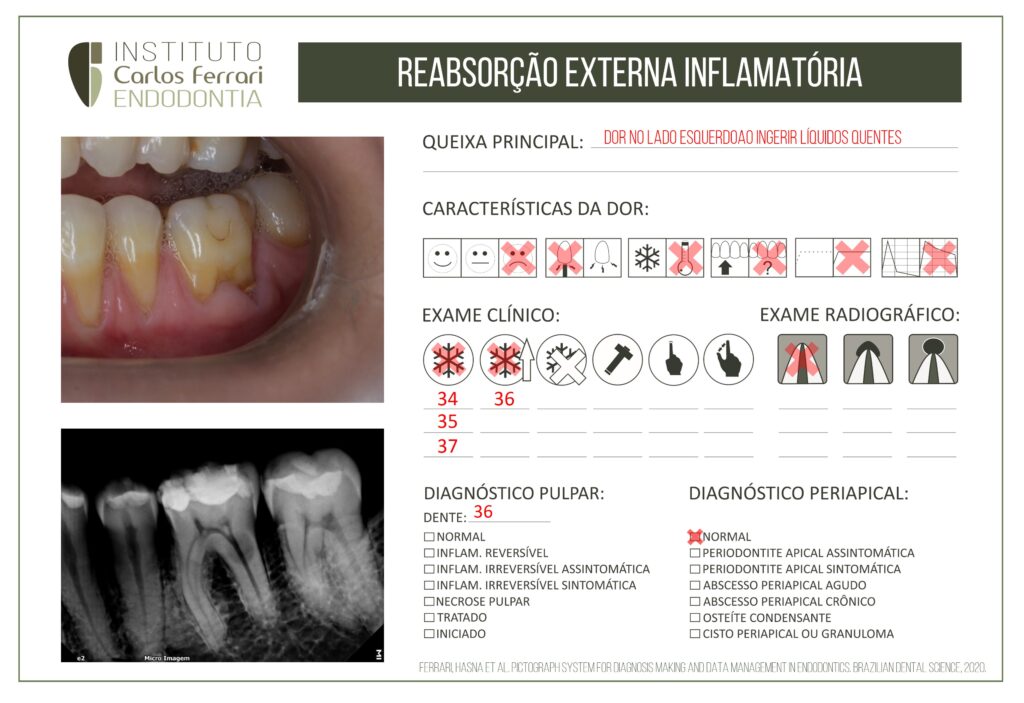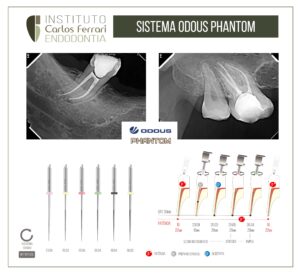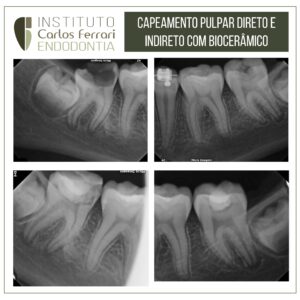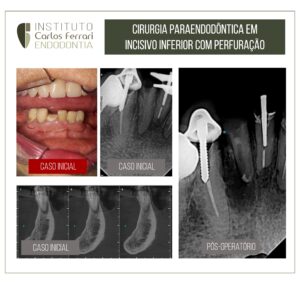Reabsorção radicular esterna inflamatória.
Paciente encaminhada à clínica queixando-se de dor no rosto na região inferior esquerda, ao quente. Dor difusa de declínio lento. Ao exame clínico, dor exacerbada ao frio no dente 36, portanto, diagnóstico pulpar de inflamação pulpar irreversível sintomática. O exame radiográfico revelou imagem compatível com reabsorção radicular externa na raiz distal. O dente foi acessado
A tomografia revelou que a reabsorção tinha comunicação com o canal radicular.
Foi realizado rebatimento do retalho em envelope para o fechamento da lacuna de reabsorção com MTA e posteriormente, na mesma sessão o tratamento endodôntico.
A paciente foi então encaminhada ao periodontista para a restauração da região exposta ao meio com resina e demais cuidados periodontais.

Reabsorção radicular externa
In: Endo et al. Arquivos do MUDI, v19, n2-3,p. 43-52.
INTRODUÇÂO: De acordo com o glossário da Associação Americana de Endodontia, a reabsorção radicular é definida como uma condição associada a um processo fisiológico ou patológico que resulta na perda de dentina, cemento ou osso (NE; WITHERSPOON; GUTMANN, 1999). A reabsorção fisiológica ocorre na dentição decídua durante a esfoliação e permite o irrompimento do seu dente permanente sucessor (HAROKOPAKIS-HAJISHENGALLIS, 2007; PATEL; KANAGASINGAM; PITT FORD, 2009). Por outro lado, a reabsorção patológica pode ocorrer após injúrias traumáticas, movimentação ortodôntica, inflamações crônicas de origem infecciosa dos tecidos pulpares ou periodontais, procedimentos cirúrgicos, e pressão excessiva de um dente impactado ou um tumor (FUSS; TSESIS; LIN, 2003).
As reabsorções podem ser classificadas em reabsorção interna ou externa. A reabsorção radicular interna éum processo inflamatório iniciado na face interna da cavidade pulpar com a perda de dentina, podendo alcançar o cemento (FUSS; TSESIS; LIN, 2003). Sua etiologia não está totalmente estabelecida, sendo que o trauma é o principal agente etiológico (CALISKAN; TURKUN, 1997).
Enquanto a reabsorção radicular externa é uma perda da estrutura dentária, iniciada por uma área mineralizada ou desnuda da superfície radicular. Ambas as reabsorções dependendo da sua progressão podem causar danos irreversíveis à estrutura dentária, necessitando um tratamento e monitoramento adequados. Pelo fato da reabsorção radicular inflamatória ser usualmente de origem infecciosa, deve-se aplicar estratégias antimicrobianas para favorecer o prognóstico (CVEK, 1973; SJOGREN et al., 1997).
Em diversas situações clínicas, as radiografias periapicais não permitem um diagnóstico seguro e preciso das reabsorções dentárias, entretanto existem casos em que a identificação do tipo de reabsorção, seu grau de evolução, seus limites e sua causa não seja definitivamente possíveis de ser determinados.Sendo assim, a tomografia computadorizada de feixe cônico mostra-se como um recurso adicional na detecção das reabsorções radiculares (COHENCA et al., 2007; REN et al., 2013), e apresenta baixa dose de radiação quando comparadaa tomografia computadorizada convencional,além de incluirvantagens como melhor precisão e resolução.Esta tecnologia oferece uma imagem em três dimensões, eliminando a sobreposição de imagens como observado nas radiografias periapicais





